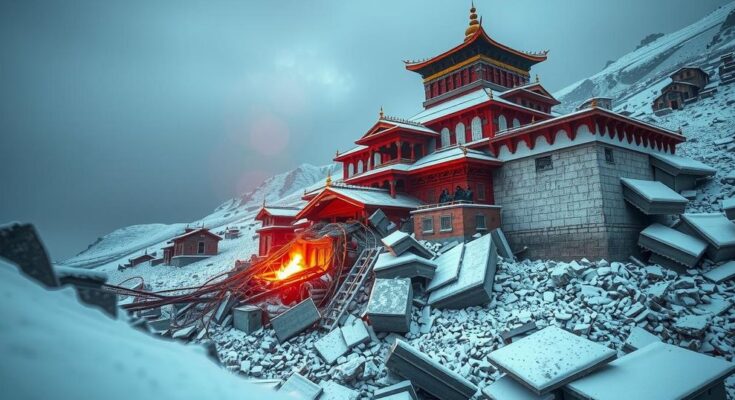A powerful earthquake measuring 7.1 in magnitude struck Tibet, China, on Tuesday, resulting in at least 126 fatalities and injuring 188 others. The tremors were felt into Nepal, prompting extensive rescue operations amid significant damage to local infrastructure. The incident, marked by numerous aftershocks, highlights the ongoing risk of seismic activity in this region.
On Tuesday, a 7.1-magnitude earthquake struck the remote region of Tibet, China, and parts of Nepal, resulting in severe devastation. The natural disaster has claimed the lives of at least 126 individuals while injuring approximately 188 more in Tibet alone. Rescue efforts are ongoing, with emergency personnel sifting through debris in search of survivors. Over 1,000 homes have sustained damage, with significant destruction reported in various villages. The quake, occurring at a shallow depth of 10 kilometers, has resulted in around 150 aftershocks, causing further concern among local residents.
The epicenter of the earthquake was identified in Tingri County, where the convergence of the Indian and Eurasian tectonic plates occurs, making this area prone to seismic activity. Videos released by Chinese officials depicted rescue teams navigating through collapsed structures, emphasizing the urgency of the situation. Despite the tremors being felt in neighboring Nepal, initial assessments indicated no injuries or major damage reported there. The terrain surrounding Mount Everest, located approximately 75 kilometers from the quake’s epicenter, was notably secluded during the winter season.
Chinese authorities, including President Xi Jinping, have mobilized over 3,000 rescuers and allocated 100 million yuan (approximately $13.6 million) to support disaster relief efforts. Government officials are focusing on rescue operations, minimizing casualties, and providing necessary aid to those whose homes are affected. As the situation unfolds, the resilience of the local community in recovering from this disaster will be vital, considering the harsh living conditions at high altitudes in the region.
The tectonic landscape of Tibet and the surrounding regions is marked by the collision of major geological plates, notably the Indian and Eurasian plates. This collision leads to the formation of the Himalayas and causes frequent seismic events, making Tibet particularly susceptible to earthquakes. The area has a sparse population, but even a minor quake can have devastating impacts due to the fragile construction of homes. Given its high altitude and remote nature, the aftermath of such natural disasters poses unique challenges for rescue and recovery efforts.
In summary, the recent 7.1-magnitude earthquake that struck Tibet has resulted in significant loss of life and injuries, along with widespread destruction of infrastructure. Rescue operations are underway amid multiple aftershocks, and the Chinese government has responded swiftly to provide support and relief for the affected communities. The incident underscores the vulnerability of high-altitude regions to seismic activity and the enduring hardship faced by residents in such environments.
Original Source: www.marca.com




